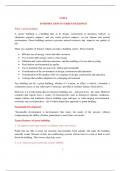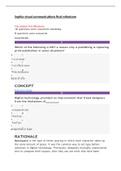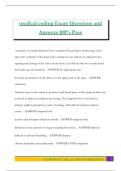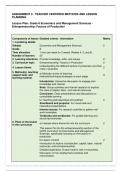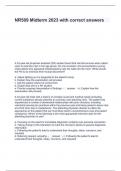MCB3025F
Proteomics
Lecture 1: Introduction to proteomics
Part A
- proteomics is the study of the subsets of proteins present in different parts of the organisms and how they change with
time and varying conditions
- the proteome is the protein complement of the genome
Interrelationships in the cell
- The genome is in the nucleus of the cell and at any given time, a certain group of
genes would be expressed, and this is based on the function of that cell
- those genes being expressed are known as the transcriptome
- transcription takes place, generates a group of messengers RNAs, the
transcriptome, which is then transported into the cytoplasm
- in the cytoplasm, the mRNA is translated into proteins and collectively make up
the proteome of the cell
- the proteome consists of proteins which have a number of specific functions in the cell (can be enzymes, regulatory
proteins) and the environment in which the cell occurs would impact the proteome
- the proteome would be detected in the environment through signal transcription, transduction type systems
- this turns on or off the expression of certain genes which are expressed to produce certain enzymes which then convert
various components into small molecules which make up the metabolome of the cell
- those would be nutrients and other compounds and would also interact directly with the proteome
- Summary: there is interaction and overlap between the various compartments of the cell in terms of gene expression, the
transcriptome which is a reflection of the genes being expressed in the cell at any given time, mRNA is generated from
actively transcribed genes which are translated into proteins which make up the proteome and the environment interacts
with the metabolome as well as the proteome, dictating what processes occur in the cell, in response to the function of that
cell or the tissue in which the cell occurs
Proteins
- proteins are generally the biochemical machinery in the cells
- many are enzymes that catalyze tens of thousands of biochemical reactions
- others are regulatory proteins that contribute to the correct gene expression
- some are structural proteins that build the many cellular components (such as ribosomes, Golgi apparatus, the cytoskeleton
of the cell which is made up of actin)
- some proteins are carriers that move molecules around in the cells or between cells 9they bind compounds and carry them
to where they need to be)
Proteomics
- annotation of genomes: deciding the functions and names of the individual genes that constitute the genome and is done
primarily at the level of the proteome
- while the genome is essentially identical in all cells in an organism, the set of expressed proteins varies extensively
through time as well as according to the specific conditions a cell finds itself in
- in terms of expression, different genes are expressed in different organs because organs have different functions and
therefore require a different set of proteins
- in terms of time, during development, limbs are being generated and organs are generated and will find that over that time,
different proteins are being expressed as the embryo develops and the proteome changes
- the conditions a cell finds itself in also impacts expression, for example different proteins will be expressed under stress
conditions such as stress response proteins and heat shock proteins compared to the optimal conditions of the environment
The term proteome may be used with several meanings
1) All the proteins encoded by the genome of a species
2) Set of proteins expressed in a particular cell (or tissue or organ) at a particular time and under specific conditions
3) Set of proteins of a subcellular structure or organelle
- the proteome is a dynamic, complex network that responds quickly to environmental change and often does so
independently of the genome (without requiring transcriptional activation)
- accomplished through the multi-functionality of many proteins, numerous post-translational modifications and protein-
protein interactions
,- the study of both post translational modifications and protein-protein interactions offers the opportunity to elucidate the
signaling events that translate environmental stress into a biochemical response at the cellular level
Proteomics and protein chemistry difference
- both proteomics and protein chemistry involve protein
identification
- protein chemistry looks at the structure of a single protein
and what its function is (how protein structure affects
function)
- proteomics identifies what proteins make up the proteome
at any given point in time and mainly to look at how the
system, as a whole, functions
Part B
Why use proteomics if we can measure gene expression
- oligonucleotide microarrays contain a series of gene-specific oligonucleotides or cDNA sequences on a slide or a chip
- by applying a mixture of fluorescently labelled DNAs from a sample of interest to the array, one can probe the expression
of thousands of genes at once
- shows a glass slide on which 6000 gene sequences from yeast have been printed onto and to look at how gene expression
is affected by a particular condition, could take the yeast cells, isolate mRNA in that culture, convert it to cDNA (single-
stranded DNA probe) which can be used to hybridize to similar sequences on the slide
- can isolate mRNA from yeast at an elevated temperature and that mRNA will include RNA form genes which are involved
in heat stress
- mRNA converts to cDNA and the mRNA from the heat stress sample can be labelled with a red fluorescent dye and the
RNA from the control sample at the ambient temperature can be labelled with green dye
- mix and will hybridize based on sequence homology to gene sequences or oligonucleotides to which they are similar
- yellow signal means that there is an equal amount of mRNA labelled with the green due and an equal amount of the
mRNA from the stressed sample labelled with red as both hybridize to that particular sequence
- red means there is more mRNA hybridizing from the stressed sample and so any red dots
represent the genes which are upregulated in their expression in the stressed yeast
- any green dots indicates which genes are downregulated or turned off in the stressed sample
- microarray can quickly see the expression of genes in yeast from a heat shocked culture compared
to a control and each of the oligonucleotides on the slide are known and the genes they came from
has been annotated so can quickly identify which genes were upregulated or downregulated
Why use proteomics summary
- mRNA levels do not necessarily predict the levels of the corresponding proteins in a cell as mRNA levels is not
proportional to protein levels as mRNAs are much less stable and have short half-lives
- differing stability of mRNAs and different efficiencies in translation can affect the generation of new proteins
- once formed, proteins differ significantly in stability and turnover rates
- mRNA levels tells us nothing about the regulatory status of the corresponding proteins, whose activities and functions are
subject to many endogenous post translational modifications and other modifications by environmental agents
Protein and mRNA relationship
- graph illustrates how the amount of mRNA present in a cell does not scale 1 to 1 with
the amount of protein in the cell
- x axis shows increasing amount of mRNA in human tissues and y axis shows amount of
protein being detected and quantified in these cells making up these human tissues
- looked at the expression of 5 genes and compared I t to the amount of protein expressed
from those genes, if had a 1 to 1 ratio, would have a diagonal line but this is not seen
- the closest one to a 1 to 1 ratio if gene 4
Proteomics: An analytical challenge
- analysis of gene expression by microarrays and related methods relies on two essential tools: polymerase chain reaction
(PCR) and hybridization of oligonucleotides to complementary sequences
- no analogous tools for protein analysis
- each protein gene product does not necessarily result in only one molecular entity in the cell
- posttranslational modification: the extent and variety of modification varies with individual proteins, regulatory
mechanisms within the cell and environmental factors
- consequently, many proteins are present in multiple forms
, - the necessity of detecting and differentiating between multiple protein products of any particular gene adds much to the
analytical challenge of proteomics
- proteomics should be able to detect and differentiate the different types of protein products within the cell
The life cycle of a protein
- a gene gets expressed, produces mRNA, goes into the cytoplasm and
gets translated into a polypeptide
- the polypeptide gets folded into a secondary structure of the protein
through Sulphur-Sulphur bridges and various folding that occurs due to
the sequence of the protein
- the protein becomes functional, post translational modifications can
be added which then determines where the protein may be transported
to and where it carries out its function
- are also reversible PTMs, over time, proteins get damages or need to
be recycled when they are turned off
- they get ubiquitinated which is a post translational modification that a
polyubiquitin chain acts as a flag to allow the proteins to become
associated with proteosomes which degrade and breakdown the protein
into peptide fragments which get broken down into amino acids
- amino acids get recycled and attached to aminoacly0tRNA and goes
back thorough the translational system
Tools of proteomics
Analytical protein-separation technology
- when you isolate protein from a cell or tissue, get a mixture of proteins which can have hundreds of thousands of proteins
- in order to characterize this proteome further, need to simplify this mixture
- if have too complex a mixture, the system will miss a lot of proteins
- simplify complex protein mixtures by resolving them into individual proteins or small groups of proteins and allows
investigators to target specific proteins for analysis
- can target specific proteins for analysis and can set up affinity columns which bind proteins with a particular PTM and pull
those out of the complex mixture to be analyzed further
Mass spectrometry (MS)
- provide accurate molecular mass measurements of intact proteins as large as 100 kDa
- provide accurate mass measurements of peptides from proteolytic digests (can treat the protein mixture with trypsin which
is a protease which cuts up the protein specifically into peptides and we can then determine the mass of those peptides in the
mixture)
- provide sequence analysis of peptides obtained from proteolytic digests
Software
- can match de novo sequences from mass spectrometry data with specific protein sequences in databases
- can match uninterpreted MS data to sequences in protein, EST, and genome-sequence databases with the aid of specialized
algorithms allowing us to identify what the protein or the peptide is
- can use expression sequence tags databases or DNA sequence databases where work backwards and generate proteins that
would be translated from these cDNA sequences or from these annotated genes within a genome sequence database
The database
- protein or Expression Sequence Tag database, and complete genome sequence databases collectively provide a complete
catalogue of all proteins expressed in organisms for which databases are available
- used for matching out spectra or de novo sequences obtained from out peptides to identify hat the proteins are within that
proteome
Part C: Applications of proteomics
Proteomics encompasses four principal applications
1) mining
2) protein-expression profiling
3) protein-network mapping
4) mapping of protein modifications
1) Mining
- the exercise of identifying all (or as many as possible) within the proteome of a particular sample
- the aim is to catalogue the proteome directly, rather than to infer the composition of the proteome from gene expression
data (not using expression of mRNA levels from a microarray to dictate what proteins are present but rather identifying the
proteins directly within the proteome using proteomics)
Proteomics
Lecture 1: Introduction to proteomics
Part A
- proteomics is the study of the subsets of proteins present in different parts of the organisms and how they change with
time and varying conditions
- the proteome is the protein complement of the genome
Interrelationships in the cell
- The genome is in the nucleus of the cell and at any given time, a certain group of
genes would be expressed, and this is based on the function of that cell
- those genes being expressed are known as the transcriptome
- transcription takes place, generates a group of messengers RNAs, the
transcriptome, which is then transported into the cytoplasm
- in the cytoplasm, the mRNA is translated into proteins and collectively make up
the proteome of the cell
- the proteome consists of proteins which have a number of specific functions in the cell (can be enzymes, regulatory
proteins) and the environment in which the cell occurs would impact the proteome
- the proteome would be detected in the environment through signal transcription, transduction type systems
- this turns on or off the expression of certain genes which are expressed to produce certain enzymes which then convert
various components into small molecules which make up the metabolome of the cell
- those would be nutrients and other compounds and would also interact directly with the proteome
- Summary: there is interaction and overlap between the various compartments of the cell in terms of gene expression, the
transcriptome which is a reflection of the genes being expressed in the cell at any given time, mRNA is generated from
actively transcribed genes which are translated into proteins which make up the proteome and the environment interacts
with the metabolome as well as the proteome, dictating what processes occur in the cell, in response to the function of that
cell or the tissue in which the cell occurs
Proteins
- proteins are generally the biochemical machinery in the cells
- many are enzymes that catalyze tens of thousands of biochemical reactions
- others are regulatory proteins that contribute to the correct gene expression
- some are structural proteins that build the many cellular components (such as ribosomes, Golgi apparatus, the cytoskeleton
of the cell which is made up of actin)
- some proteins are carriers that move molecules around in the cells or between cells 9they bind compounds and carry them
to where they need to be)
Proteomics
- annotation of genomes: deciding the functions and names of the individual genes that constitute the genome and is done
primarily at the level of the proteome
- while the genome is essentially identical in all cells in an organism, the set of expressed proteins varies extensively
through time as well as according to the specific conditions a cell finds itself in
- in terms of expression, different genes are expressed in different organs because organs have different functions and
therefore require a different set of proteins
- in terms of time, during development, limbs are being generated and organs are generated and will find that over that time,
different proteins are being expressed as the embryo develops and the proteome changes
- the conditions a cell finds itself in also impacts expression, for example different proteins will be expressed under stress
conditions such as stress response proteins and heat shock proteins compared to the optimal conditions of the environment
The term proteome may be used with several meanings
1) All the proteins encoded by the genome of a species
2) Set of proteins expressed in a particular cell (or tissue or organ) at a particular time and under specific conditions
3) Set of proteins of a subcellular structure or organelle
- the proteome is a dynamic, complex network that responds quickly to environmental change and often does so
independently of the genome (without requiring transcriptional activation)
- accomplished through the multi-functionality of many proteins, numerous post-translational modifications and protein-
protein interactions
,- the study of both post translational modifications and protein-protein interactions offers the opportunity to elucidate the
signaling events that translate environmental stress into a biochemical response at the cellular level
Proteomics and protein chemistry difference
- both proteomics and protein chemistry involve protein
identification
- protein chemistry looks at the structure of a single protein
and what its function is (how protein structure affects
function)
- proteomics identifies what proteins make up the proteome
at any given point in time and mainly to look at how the
system, as a whole, functions
Part B
Why use proteomics if we can measure gene expression
- oligonucleotide microarrays contain a series of gene-specific oligonucleotides or cDNA sequences on a slide or a chip
- by applying a mixture of fluorescently labelled DNAs from a sample of interest to the array, one can probe the expression
of thousands of genes at once
- shows a glass slide on which 6000 gene sequences from yeast have been printed onto and to look at how gene expression
is affected by a particular condition, could take the yeast cells, isolate mRNA in that culture, convert it to cDNA (single-
stranded DNA probe) which can be used to hybridize to similar sequences on the slide
- can isolate mRNA from yeast at an elevated temperature and that mRNA will include RNA form genes which are involved
in heat stress
- mRNA converts to cDNA and the mRNA from the heat stress sample can be labelled with a red fluorescent dye and the
RNA from the control sample at the ambient temperature can be labelled with green dye
- mix and will hybridize based on sequence homology to gene sequences or oligonucleotides to which they are similar
- yellow signal means that there is an equal amount of mRNA labelled with the green due and an equal amount of the
mRNA from the stressed sample labelled with red as both hybridize to that particular sequence
- red means there is more mRNA hybridizing from the stressed sample and so any red dots
represent the genes which are upregulated in their expression in the stressed yeast
- any green dots indicates which genes are downregulated or turned off in the stressed sample
- microarray can quickly see the expression of genes in yeast from a heat shocked culture compared
to a control and each of the oligonucleotides on the slide are known and the genes they came from
has been annotated so can quickly identify which genes were upregulated or downregulated
Why use proteomics summary
- mRNA levels do not necessarily predict the levels of the corresponding proteins in a cell as mRNA levels is not
proportional to protein levels as mRNAs are much less stable and have short half-lives
- differing stability of mRNAs and different efficiencies in translation can affect the generation of new proteins
- once formed, proteins differ significantly in stability and turnover rates
- mRNA levels tells us nothing about the regulatory status of the corresponding proteins, whose activities and functions are
subject to many endogenous post translational modifications and other modifications by environmental agents
Protein and mRNA relationship
- graph illustrates how the amount of mRNA present in a cell does not scale 1 to 1 with
the amount of protein in the cell
- x axis shows increasing amount of mRNA in human tissues and y axis shows amount of
protein being detected and quantified in these cells making up these human tissues
- looked at the expression of 5 genes and compared I t to the amount of protein expressed
from those genes, if had a 1 to 1 ratio, would have a diagonal line but this is not seen
- the closest one to a 1 to 1 ratio if gene 4
Proteomics: An analytical challenge
- analysis of gene expression by microarrays and related methods relies on two essential tools: polymerase chain reaction
(PCR) and hybridization of oligonucleotides to complementary sequences
- no analogous tools for protein analysis
- each protein gene product does not necessarily result in only one molecular entity in the cell
- posttranslational modification: the extent and variety of modification varies with individual proteins, regulatory
mechanisms within the cell and environmental factors
- consequently, many proteins are present in multiple forms
, - the necessity of detecting and differentiating between multiple protein products of any particular gene adds much to the
analytical challenge of proteomics
- proteomics should be able to detect and differentiate the different types of protein products within the cell
The life cycle of a protein
- a gene gets expressed, produces mRNA, goes into the cytoplasm and
gets translated into a polypeptide
- the polypeptide gets folded into a secondary structure of the protein
through Sulphur-Sulphur bridges and various folding that occurs due to
the sequence of the protein
- the protein becomes functional, post translational modifications can
be added which then determines where the protein may be transported
to and where it carries out its function
- are also reversible PTMs, over time, proteins get damages or need to
be recycled when they are turned off
- they get ubiquitinated which is a post translational modification that a
polyubiquitin chain acts as a flag to allow the proteins to become
associated with proteosomes which degrade and breakdown the protein
into peptide fragments which get broken down into amino acids
- amino acids get recycled and attached to aminoacly0tRNA and goes
back thorough the translational system
Tools of proteomics
Analytical protein-separation technology
- when you isolate protein from a cell or tissue, get a mixture of proteins which can have hundreds of thousands of proteins
- in order to characterize this proteome further, need to simplify this mixture
- if have too complex a mixture, the system will miss a lot of proteins
- simplify complex protein mixtures by resolving them into individual proteins or small groups of proteins and allows
investigators to target specific proteins for analysis
- can target specific proteins for analysis and can set up affinity columns which bind proteins with a particular PTM and pull
those out of the complex mixture to be analyzed further
Mass spectrometry (MS)
- provide accurate molecular mass measurements of intact proteins as large as 100 kDa
- provide accurate mass measurements of peptides from proteolytic digests (can treat the protein mixture with trypsin which
is a protease which cuts up the protein specifically into peptides and we can then determine the mass of those peptides in the
mixture)
- provide sequence analysis of peptides obtained from proteolytic digests
Software
- can match de novo sequences from mass spectrometry data with specific protein sequences in databases
- can match uninterpreted MS data to sequences in protein, EST, and genome-sequence databases with the aid of specialized
algorithms allowing us to identify what the protein or the peptide is
- can use expression sequence tags databases or DNA sequence databases where work backwards and generate proteins that
would be translated from these cDNA sequences or from these annotated genes within a genome sequence database
The database
- protein or Expression Sequence Tag database, and complete genome sequence databases collectively provide a complete
catalogue of all proteins expressed in organisms for which databases are available
- used for matching out spectra or de novo sequences obtained from out peptides to identify hat the proteins are within that
proteome
Part C: Applications of proteomics
Proteomics encompasses four principal applications
1) mining
2) protein-expression profiling
3) protein-network mapping
4) mapping of protein modifications
1) Mining
- the exercise of identifying all (or as many as possible) within the proteome of a particular sample
- the aim is to catalogue the proteome directly, rather than to infer the composition of the proteome from gene expression
data (not using expression of mRNA levels from a microarray to dictate what proteins are present but rather identifying the
proteins directly within the proteome using proteomics)

